
Turf Product Guide 2022-2023


Turf has a lot to contend against. From divots created by golf clubs and horse hooves, to cleats planting and ripping through turfgrass, every surface matters. Increasing pressure from extended seasons, and growing demand for competitive surfaces to be in peak condition, makes courses, fields, and pitches the real focus of the contest.

For every playing surface, we know the grounds team matters most.
Working with you to understand your changing needs and to solve the challenges you face is central to the way we progress at Barenbrug USA.
Long term development and breeding
Ongoing investment in new technologies ensures continuous improvements in the quality of your playing surface through turfgrass performance and yield.
Before we were a company, we were a family.
In depth consulting and guidance
Product design and development through market interaction and research for a unique seed product experience.
Continentwide service and support
Agronomic expertise and technical help is always available to help you find immediate solutions to your grass needs on site.
Founded in 1904, Barenbrug continues to be family-owned and ran to this day. The development of new and innovative cultivars and varieties is in our roots. Through research and development, breeding, and working with golf course superintendents, sports field managers, and landscapers, we are able to develop specific seeds that meet their specific needs. In addition, we share our knowledge and experience to help you and your team excel at your craft.

3
Whatever the conditions, however tough the competition.



RESEARCH & DEVELOPMENT 6-11 TECHNOLOGIES 12-19 PRODUCTS 20-33

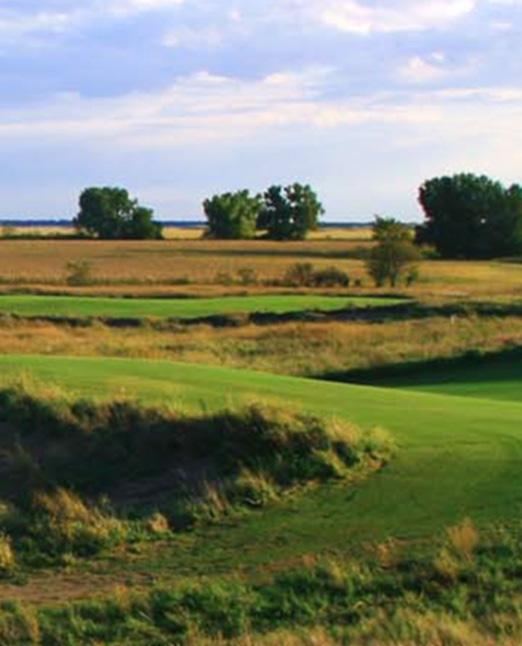
Contents 6 Research 8 Story of Grass 10 Product Development 11 New Varieties 12 HGT 14 RTF 16 RPR 18 Green Earth 19 Yellow Jacket 20 Products 22 Kentucky
24 Tall
26 Perennial
28 Annual
29 Bentgrass 30 Fine
32 Bermudagrass 36 Additional Products 37 Turfgrass Identification 38 Species & Characteristics 38 Seeding Rates Research & Development Barenbrug Technology Products Technical Information
Bluegrass
Fescue
Ryegrass
Ryegrass
Fescue
We play the long game.
It takes 15 years to breed a winner. From initial cross to seed certification, every new grass must prove itself fit for the nation’s most hallowed greens, fields, and lawns. A scientific breeding program is at the core of our business. Delivering a new cultivar to the market is a long and multifaceted process, involving people and departments across the global Royal Barenbrug Group.

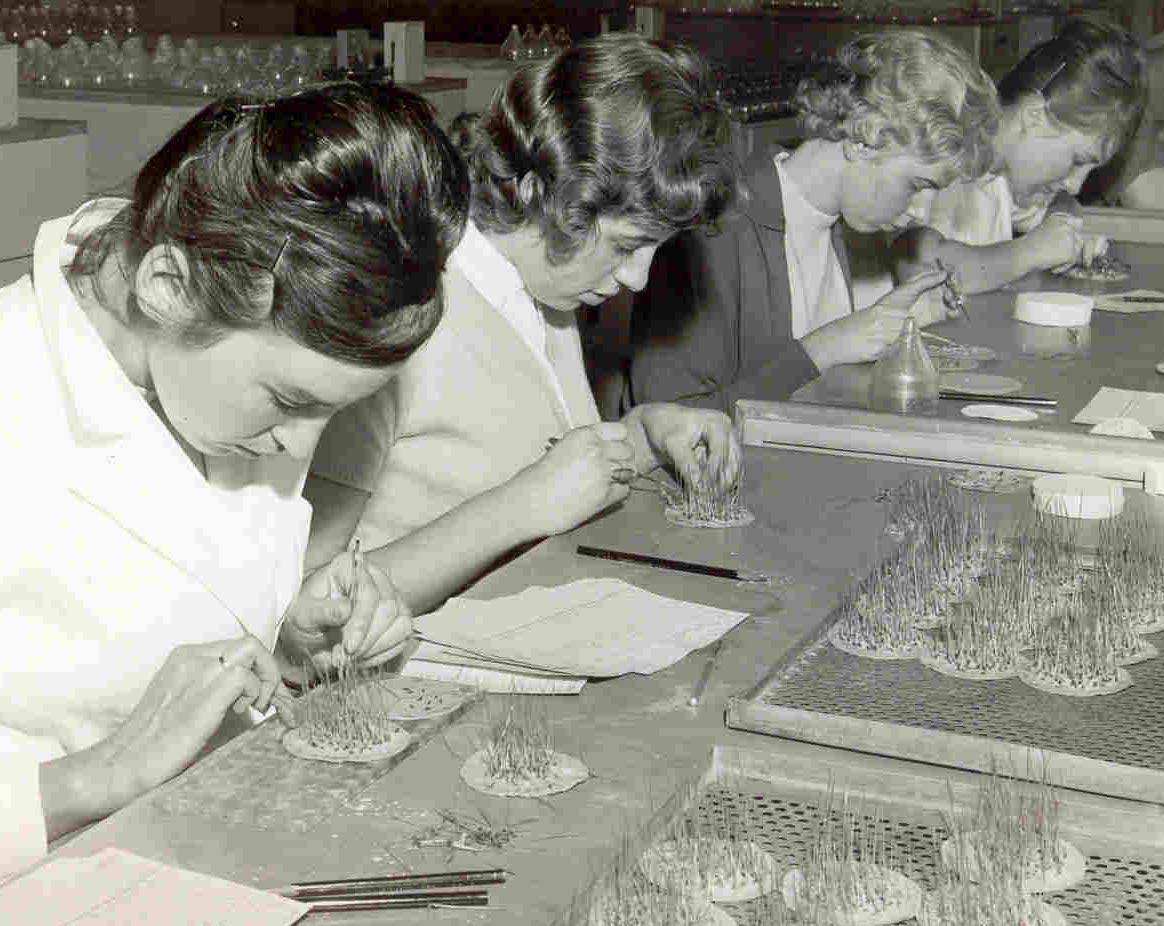
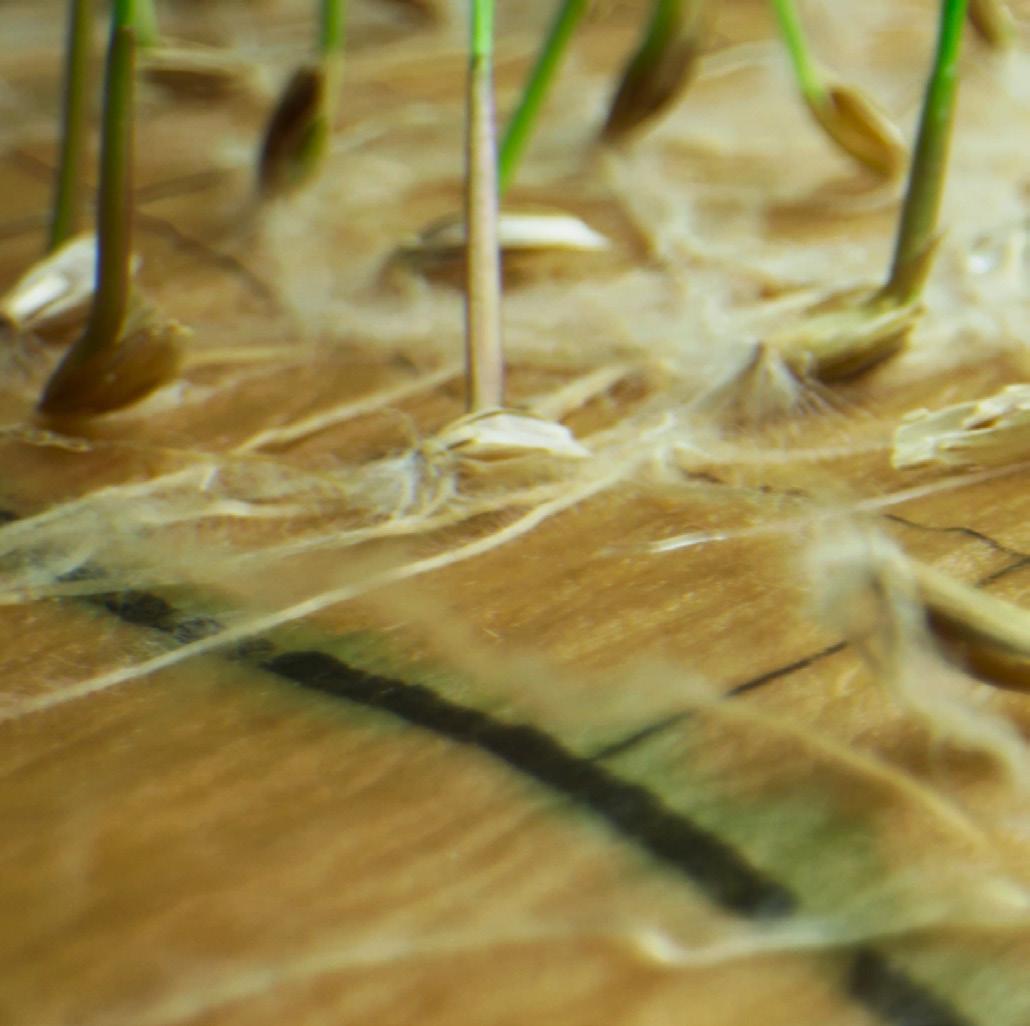
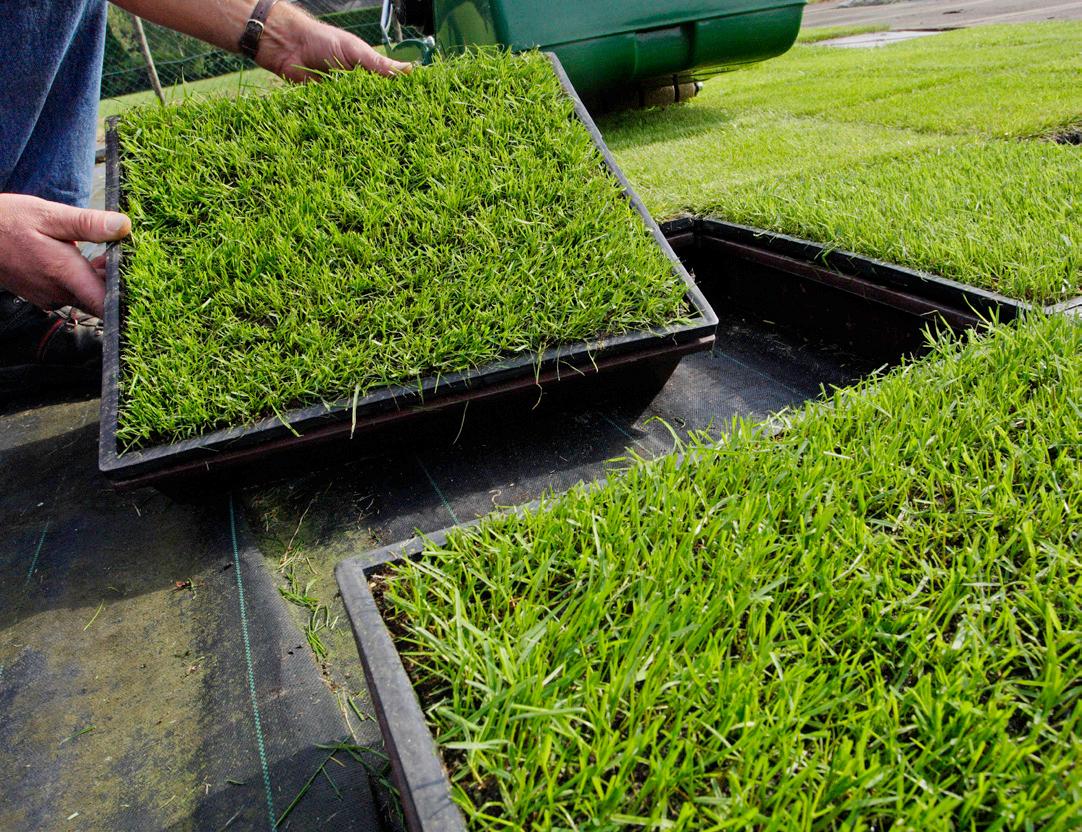
6
Stage
Stage

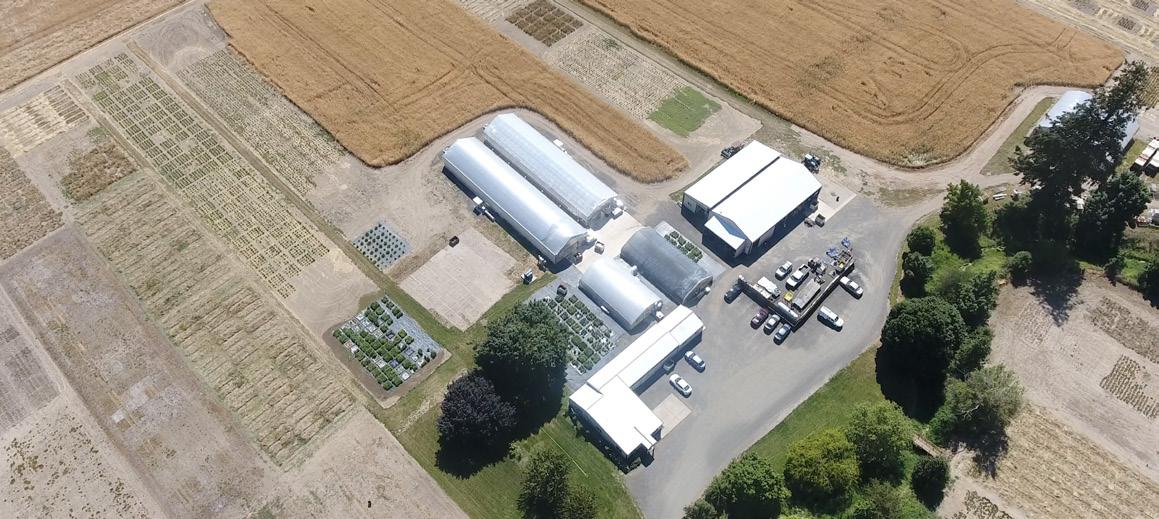





7
1 of the grass breeding process - crossing different existing cultivars
2 of the grass breeding process - selecting and testing cultivars
Climate controlled greenhouses at Barenbrug’s Albany Research facility trialing cultivars for breeding performance such as drought tolerance
Harvesting breeder seed
The Story of Grass
Each cultivar is the product of a long and rigorous cycle of breeding, selection, and testing to identify the grasses that will fill the world’s great sporting venues.
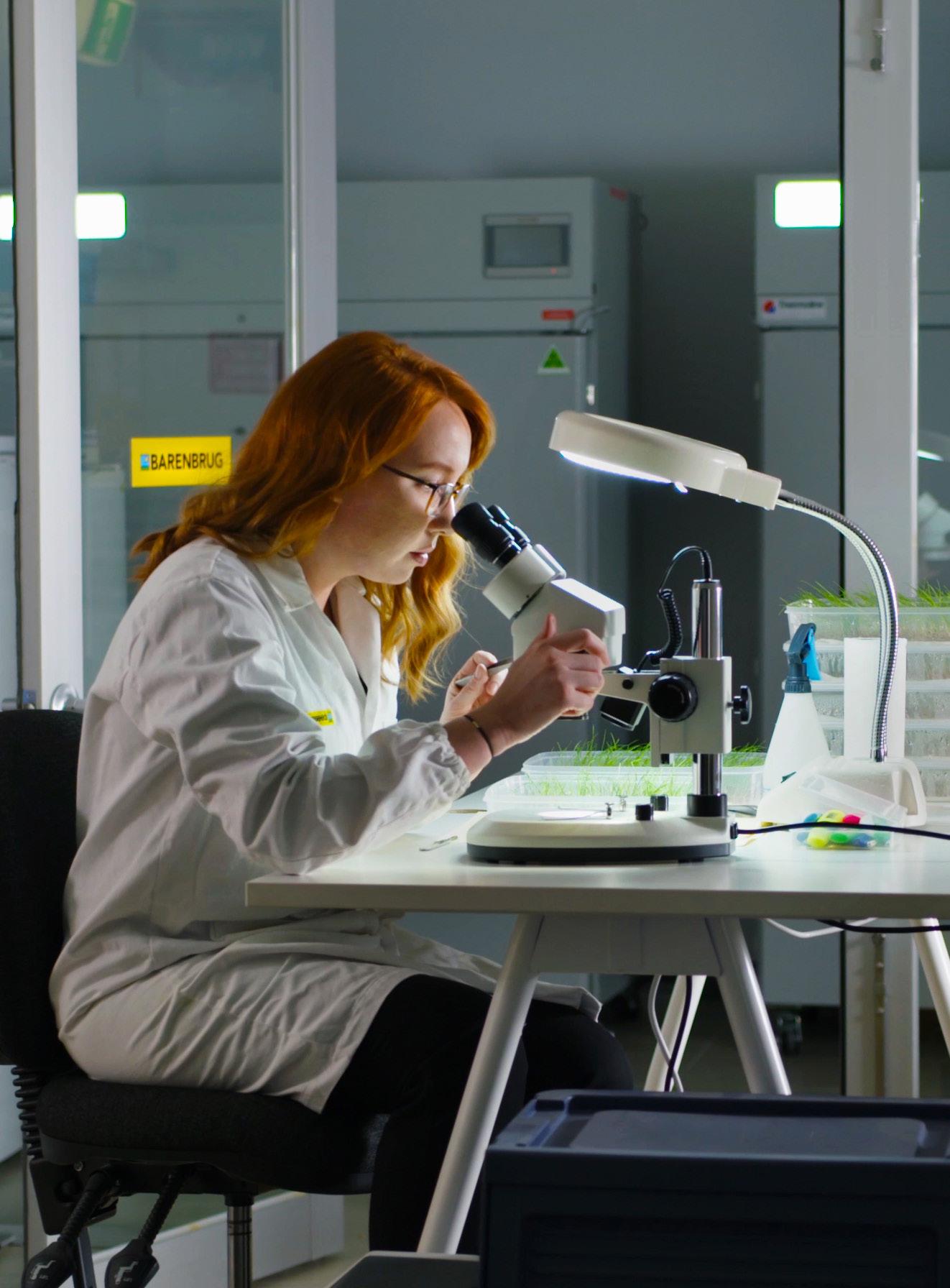
Years 1-3
Searching for candidates
Every new grass story begins at one of our breeding stations across North America. To develop a new grass cultivar, we cross plants of an existing cultivar with plants isolated from unique traits, the wild, or from a particular environment that offers interesting potential.
Years 7
The first draft pick
We pick out the best plants and group them based on similarities, allowing them to crosspollinate within each group. The resulting “synthetic line” is the basis for a new cultivar. It is important to remember that a cultivar always exists as a population of genetically different individual plants that are very similar (but not identical) to one another.
Years
8-10
Proving performance
Each new line is tested against other elite lines and existing cultivars from Barenbrug’s and competitors’ global breeding programs. They may be stress tested under simulated wear or traffic and at a low mowing height. Further trials or laboratory testing might test tolerance to a particular turfgrass disease or sustained drought conditions. This takes place at multiple locations, including our U.S. research station to ensure reliable results for wide-ranging end-user markets.
Years
4-6
Selection process
Once these crosses have been seeded, a detailed selection process identifies those with the strongest potential to perform. Individual, unmown plants in a large nursery are scrutinized for a broad range of characteristics, removing those with weaknesses to disease, heat, cold, etc. and selecting only the very best to continue on the journey.
We are looking for a range of characteristics that turf managers tell us matter most to them, such as disease resistance, climate tolerance, soil preference, color, and growth qualities. After initial selection, individual mown plants are examined to assess turf quality and persistence. This three-year process may whittle down 10,000 plants to as few as a dozen or more.
Years 11 Multiplication
The results of the performance tests indicate which lines should be multiplied to become new cultivars. Barenbrug product development teams decide on the line, based on performance data, and where it meets the range of needs of customers in our very different markets. The multiplication process is a costly one, creating the breeder’s seed stock, which will become the foundation for commercial production.
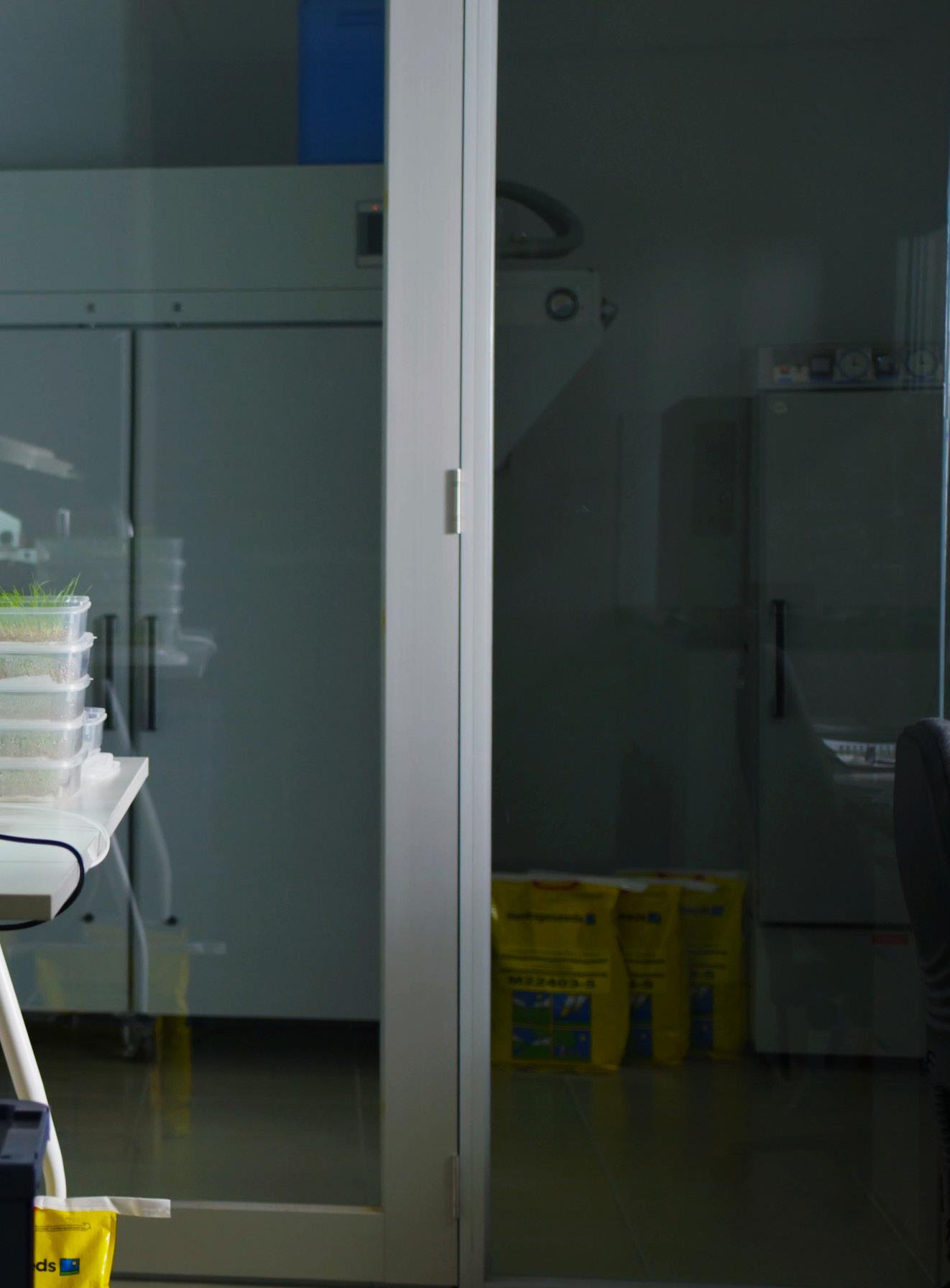
Years 12-15 Final assessment
Each cultivar, based on its intended market, is submitted to official trials across the globe. In parallel, it is necessary for a cultivar to be examined under legislative protocols to ensure it is eligible for sale. Aspects such as distinction (different from existing material), uniformity (individuals within the population must be very similar) and stability (no reversion to parental wild-type) are scrutinized over a fixed period (typically three years or longer).
Product Development and R&D
Consistent performance in grass lies in combining the strengths of different species and individual cultivars. It’s a team thing. The relationships we’ve built with customers inform our breeding programs and product development, helping us to refine selections to meet the challenges of the present. Throughout this year’s catalog, you can find grass seed blends and mixes that compound the characteristics of a range of cultivars to respond to your environment.
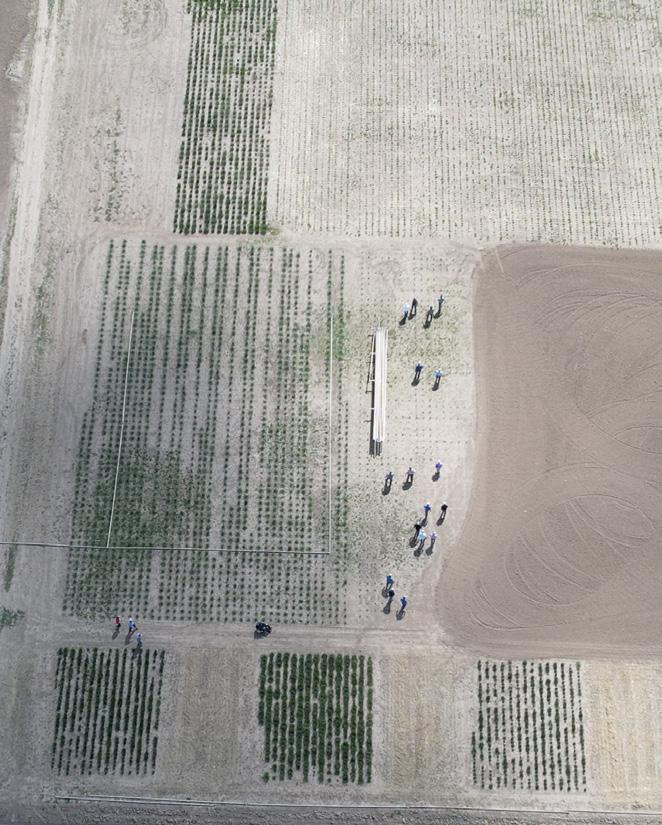

Choosing the final line-up
The mixtures of grass varieties that make up our products are the result of technical knowledge combined with customer experiences and insights from the field. Product development encompasses a range of processes; just as individual seed cultivars are trialed, products are tested to establish synergies in the performance of species and cultivars. Within each product we also look closely at the traits of individual cultivars, and how best to match those with customer needs in different sporting contexts and locations. We take this process far beyond the scope of official trials, aiming to find the best possible match for our customers around the world.
The R&D process in the U.S. is a collaborative one, with work carried out at the Barenbrug R&D site in Albany, Oregon, Kentucky, and a host of Universities around the continent.
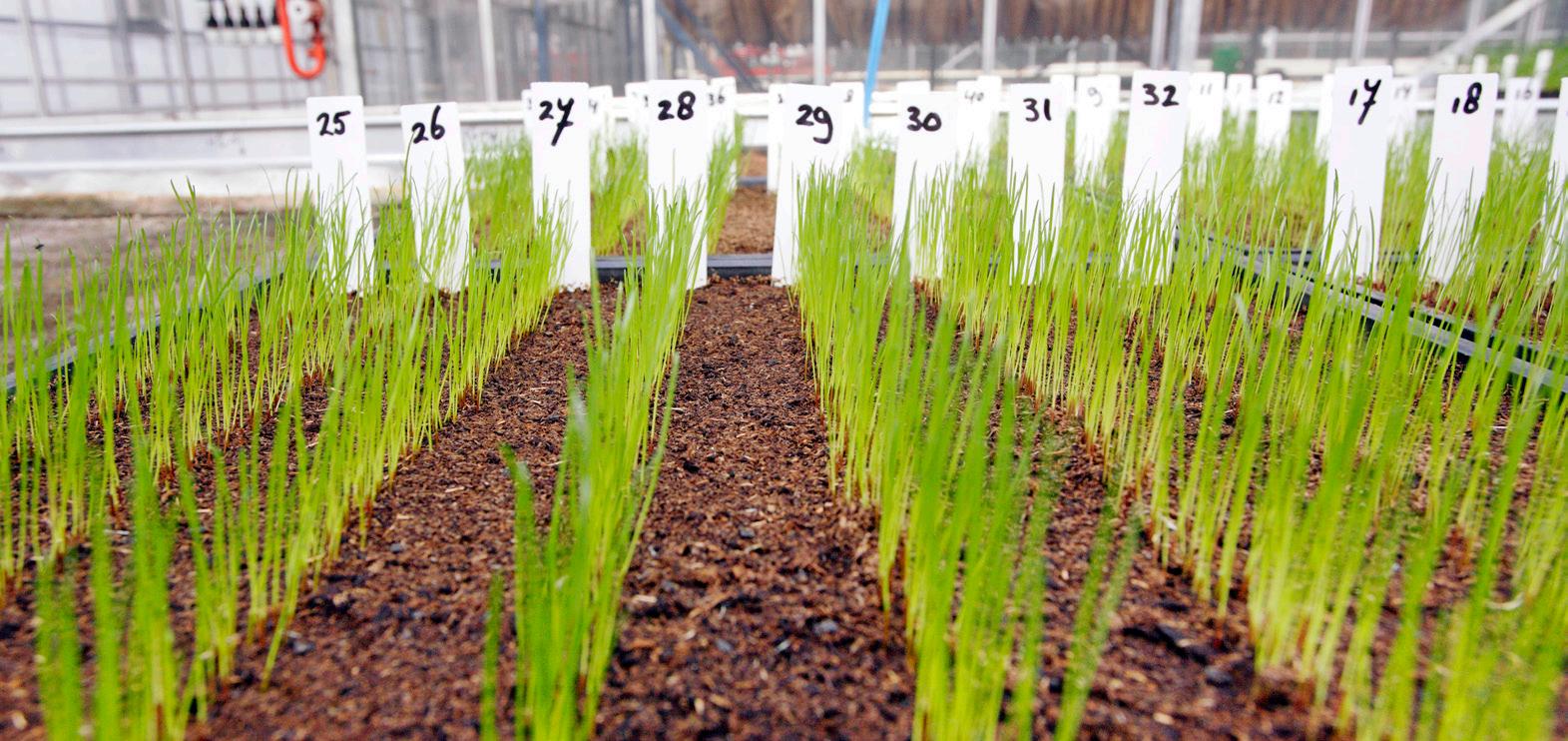
10
Trials at our research facility located in Albany, Oregon
Refined through selective breeding and proven in trials and R&D, only the best new cultivars advance to production, and when they do, the vital role of the Seed Production team commences. To make any new seed available it must first be multiplied to produce ‘breeder’ seed, which itself goes through another harvest. The resulting ‘seedstock’ seed is supplied to our specialist growers for sowing to produce the seed ready for sale.
New Varieties
Zion™: Turf-Type Tall Fescue
Zion turf-type tall fescue is up to any challenge you can throw at it: low moisture, high traffic, party-shaded areas, and even pesky turf diseases. As another hearty turf-type tall fescue offered by Barenbrug USA, Zion is a medium dark-green color with a finer leaf texture. It is also equipped with disease-fighting strengths against brown patch (cool and warm climates), gray leaf spot, and pythium blight.
Zion Key features
• Tolerance to Brown patch (cool and warm)
• Tolerance to Gray leaf spot
• Traffic and drought tolerant
Xanadu™: Turf-Type Tall Fescue

Seed Usage
The final (and most important) chapter in the Story of Grass is yet to be written. It is over to you now! This catalog showcases the products that have been created from the process above, all designed with you and your needs in mind. We trust they will be used to deliver the very best turf possible, to be enjoyed by all across the continent.
Xanadu tall fescue was developed for improved leaf texture, dark color, improved density, and resistance to brown patch disease. Xanadu’s excellent turf quality is demonstrated in multiple regions of the US in the 2018 NTEP, including the Southeast, Mountain West, Northwest, and Transition Zone. Xanadu is also earning impressive ratings for performance under shade and drought conditions.
Xanadu Key features
• Excellent Brown Patch Resistance
• Good Traffic Tolerance
• Top Rated in the 2018 NTEP for Drought
• Excellent NTEP Quality Ratings Across Multiple Regions and Management Regimes
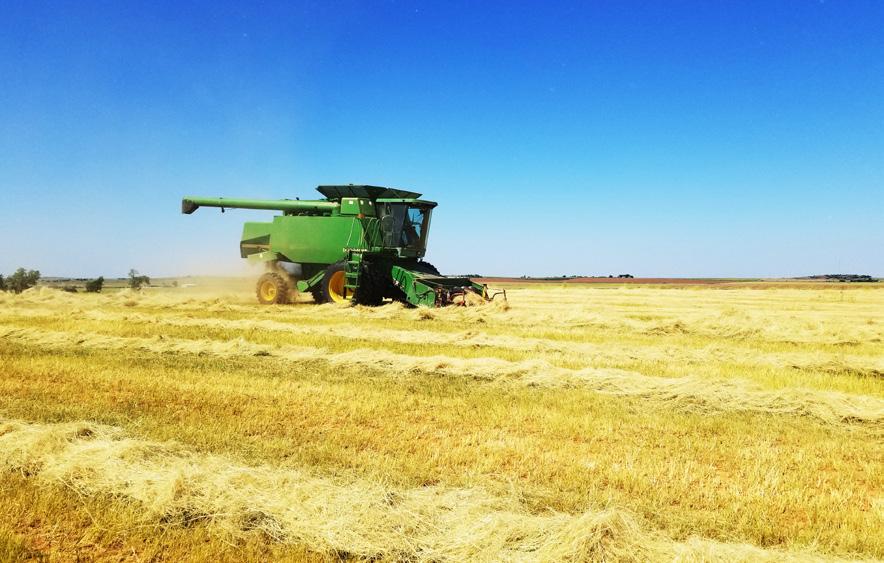
11
Production: Packs with Potential
Healthy Grass Technology®
Kentucky Bluegrass Engineered for Turf Health

Developed from extremely traffic tolerant parent stock and within harsh climatic conditions, Barvette HGT® came out of Barenbrug’s research program solving each of the major species-wide problems, and possesses many additional qualities making it one of the most unique Kentucky bluegrasses ever bred.
Germination and Establishment
Quick germination and rapid establishment are terms rarely associated with Kentucky bluegrass. Barvette HGT, however, didn’t get the memo. With germination typically beginning in fewer than 10 days and aggressive, rapid establishment, Barvette HGT is a ‘game changer.’ Fields can recover quicker, fairways can now be successfully renovated and tee complexes rotated through quicker. Weeds also face greater competition against HGT’s aggressive growth habit. For bluegrass sod production, fields establish more quickly for harvest, field yields increase and pallet quality shines.
Traffic Tolerance and Rapid Recovery
Barenbrug’s HGT® blend with Barvette HGT offers outstanding traffic tolerance and wear recovery. In research studies at Michigan State University, Barvette HGT was trialed with 109 commercial varieties, and came out on top for wear recovery, percent ground cover, and turf quality. Likewise, in the NTEP traffic stress tests, Barvette HGT topped all other entries at Michigan State University and Rutgers University trials.
12 T ECH NO L OG Y heal t h y g r a s s TM
Prospect Fields Hamilton, OH “Barenbrug’s HGT continues to impress with now over 80 games played on these fields!”
Grubs and Billbugs? No Problem.
White grubs and billbugs can commonly devastate Kentucky bluegrass turf. HGT varieties, led by Barvette HGT’s #1 ranked performance against white grubs in the 2006-10 NTEP trial, provide excellent tolerance to turfgrass insect pests. With more communities and facilities reducing or eliminating the use of turfgrass insect controls, Barenbrug’s HGT blend provides safe, natural, “green” protection.
NTEP Billbug Trial: USU, 2008
Variety July
4-Season 7.7
Barvette HGT 7.0 Prosperity 6.7 Green Team 4.3 Bandera Texas Hybrid 2.7 Reveille 2.0
LSD=2.8
NTEP White Grub Trial: U.T., 2010
Variety Mean
Barvette HGT 23.0 Midnight 35.8 Reveille 47 Bandera 49.2 Prosperity 62.5 Green Team 65.3 LSD=22.3
Resistance to Summer Patch and Rust
Summer patch and stem rust are serious turf diseases that cause significant damage to most Kentucky bluegrass varieties. Tested intensively at many locations across the country and in university trials, Barvette HGT has shown excellent resistance to summer patch and stem rust. Following the 2005-10 NTEP trials, Barvette HGT ranked #1 in summer patch tolerance, and topped the first statistical grouping for stem rust resistance.
Percent Cover (0-100%)
Turf Quality (1-9)
Exceptionally Strong Spring Green-Up
Spring green-up is an important trait sought after when developing new Kentucky bluegrasses. While most bluegrasses are very slow to break winter dormancy, Barvette HGT exhibits early spring green-up. In the 2005-10 NTEP trials, Barvette HGT finished in the top statistical group. This allows the HGT blend to come back early and strong for spring play.
Variety Transition Zone TQ Spring Green-up
Barvette HGT 6.6 6.3
SRx466 6.6 5.7 Barserati 6.5 5.7 Blue Note 6.4 5.3 Midnight 6.1 3.7 Shamrock 5.5 5.7
Rating: 1-9 LSD=0.6 5 Locations LSD=0.5 13 Locations
Scan here to learn more about HGT

13
Rhizomatous Tall Fescue®
It’s Fescue, but Better

Our RTF® program has an extensive history of breeding and development so you can be sure when you choose RTF, you’re choosing tried and true varieties.
The significance of rhizomes in turf is their ability to repair damaged areas, maintain a more uniform turf density, increase sod tensile strength, survive heavily damaging periods, and reduce the need for frequent overseeding. These rhizomes spread laterally and are not as invasive as those of Kentucky bluegrass or creeping red fescue.

What are
Rhizomes?
A rhizome is a horizontal plant stem, most often found underground. They are valued, because they send out new tillers, which emerge several inches away from the mother plant. Barenbrug’s patented RTF® has the highest amount of rhizome activity when compared against similar varieties that claim to exhibit rhizomes.

• Rapid development of a durable root system
“The Climate in Omaha is quite severe. RTF outperforms every time.”
Eric McPherson CGCS
14
• Excellent drought and heat tolerance with less irrigation • Adaptable to a wide range of soil conditions • High level of traffic tolerance • Dense turf without open areas prevents weed growth • The only Tall fescue with true rhizomes that can quickly fill in damaged or open spots with new grass • Environmentally friendly, reduces chemical and fertilizer inputs • Stands up to intense summer heat • Endophyte enhanced for improved insect and disease resistance, as well as drought tolerance Uses Less Water Self-Repairing Technology Reduced Inputs
Rhizomes Shooting from RTF plants
Grass With
Omaha Country Club
‘Mow’tivation
Recovery and Repair
Turf Saver RTF exhibits very strong traffic tolerance and recovery when compared to traditional tall fescue. Tall fescue is typically a bunchgrass with very limited ability to repair and recover, however, RTF’s unique rhizome development enables the repair and recovery of the turf. The rhizomes provide the ability to repair damaged areas, maintain uniformity and density, add to drought tolerance and reduce the need for frequent overseeding. Our Turf Saver RTF provides not only a dense turf canopy with a lush dark green color, but it additionally provides a softer texture and feel to its leaves than other tall fescues.

Rhizomes To The Rescue
Rhizomes are valued because they send out new tillers underground which emerge several inches away from the mother plant. Other varieties produce very few short rhizomes, while our RTF produces numerous long rhizomes. The graph below shows the difference researchers found between Barenbrug RTF cultivars against others on the market. Designed to compare overall rhizome production; the cultivar rhizomatous index is derived by multiplying the number of rhizomes times the percentage of plants with rhizomes and the rhizome length. Multiplying the traits together in a single mathematical index helps to identify the true rhizomatous plants from the others. When you put it all together, Turf Saver RTF is in a class of its own.
Rhizomatous Index*

15
*percent of plants with rhizomes x number of rhizomes/plant x rhizome length
Grande II Falcon IV Kentucky 31 BRBRG Experimental Barmesh Titan Rx Crossfire 3 BRBRG Experimental BRBRG Experimental BRBRG Experimental 3rd Millenium Defiance Lexington AT BRBRG Experimental Labyrinth Titan Ltd Titan Ultra BRBRG Experimental BRBRG Experimental BRBRG Experimental 0 2 4 6 8 10 12 14 LSD
Scan here to learn more about RTF
= 4.03
Regenerating Perennial Ryegrass®
Determinate Stolons
In 2009, Barenbrug’s innovative research and development team introduced a unique Perennial Ryegrass subspecies to the turf industry: RPR®. Receiving its utility patent in 2015, RPR can tolerate extremely heavy traffic and displays outstanding recuperative abilities. It provides excellent turf quality and appearance in the harshest of conditions, starts off on the right foot with fast establishment, and continues to thrive through summers. RPR is the ideal selection for all applications receiving consistent, destructive traffic.

Traffic Tolerance
After traffic was applied in trialing, regeneration of the plants was evaluated by measuring the surface area of plants. RPR plants regenerated and filled in space, while non-RPR plants did not.
Beware of Imitators
Since its introduction in 2009, RPR has proven to be a strong, durable performer. As is common with success, several other seed companies are now claiming similar levels of performance from spreading perennial ryegrasses. These products, however, do not produce determinate-stolons and are not capable of regeneration after severe traffic. RPR is so unique, it has a category of its own – Lolium perenne ssp. stoloniferum.
Utility Patent: #8,927,804
Scan here to learn more about RPR

16
“Repeated seedings over the entire playing surface with RPR produced a steady improvement in overall turf quality. RPR has literally been a life saver!”
Don Moody, Grounds Supervisor
Years of ResearchRemarkable Results
RPR first drew the attention of turfgrass plant breeders at the Barenbrug research site in Virginia where new grasses are developed for traffic, drought and cold tolerance. Researchers noticed that RPR was thriving under very difficult conditions, producing determinatestolons and recovering in areas of highest traffic stress.
With the best plants selected, continued development of RPR was performed at Barenbrug’s turf research center in Oregon. Utilizing the technique of space plants and frequent mowing, Barenbrug’s turfgrass breeders studied the lateral growth of RPR comparing it to a typical perennial ryegrass blend.

Proven Results
What is a Determinate Stolon?
RPR’s unique ability to regenerate separates it from both traditional and lateral spreading perennial ryegrasses. A product of advanced determinate stolon breeding techniques, RPR develops determinate stolons which allow for regeneration in all directions. Determinate stolons arise from an auxiliary bud near the base of the mother plant and then grow horizontally 6-8” at, or just below, the soil surface creating identical new plants as they grow. When RPR turf is damaged from persistent or extreme traffic events, its determinate stolons will grow horizontally into the worn areas, develop roots and repair the damaged area. The photos to the right show RPR plants, determinate stolons, and developing roots.
Competitor perennial ryegrass blend *Area in Inches
Determinate Stolons from RPR plants


Intense Traffic Tolerance Turf Quality
Research plots were rigorously subjected to damage by a traffic simulator revealing RPR’s ability to maintain quality and integrity despite three days of traffic.
After a long summer of heat stress, RPR rated significantly higher in turf quality over an average of three perennial ryegrasses.
17
Growth Over a Year* RPR 38.5” Year One Year Two 48” 56” 87.5”
RPR RPR Non-RPR Non-RPR 0 0 Ohio State University Iowa State University 3 6 3 9 6 9
Green Earth™
In Barenbrug’s product development process, we highly value the economically and ecologically sound use and management of grass. Barenbrug’s Green Earth quality label helps green space managers to achieve a more sustainable use and management of grass. Through extensive research and many years of expertise, Barenbrug knows better than anyone else which cultivars and mixtures can make an even bigger contribution to the sustainable use and management of grass. All cultivars and mixtures that bear the Green Earth quality mark have been independently tested by research institutes nationwide. Through Green Earth, Barenbrug hopes to make a contribution to a green planet on which future generations will be able to continue playing sports and enjoying recreational activities.
The Four Pillars of Green Earth
Barenbrug has formulated four concrete requirements which grass cultivars or mixtures need to improve upon in order to be eligible for this sustainability quality mark. A Green Earth label means that the grass scores better than the previous generation in terms of at least one of the following aspects:
• Reduced Water Use
• Reduced Inputs
Resources

•
Reduced Mowing

•
Increased Salt Tolerance
In a world where we face increasingly extreme summer heat, insects ruining harvests, harsh winters killing and preventing the grass from recovering in time for the next season, and unpredictable weather patterns year in and year out, we are grateful for the opportunity to bring responsible management of our scarce resources with greater efficiency. Fortunately, grass offers more solutions than you might think. This is why we invent products that reduce the use of water, fertilizers, and other energy inputs. We value sustainable answers for compelling issues.
18
Green Earth Family of Products p.25 Drought Destroyer™ - Mix p.25 Water Saver® - Tall Fescue p.23 Turf Blue® Pro - KBG p.25 Pollinators Paradise™ - Mix p.31 Shade Savant™ - Mix p.36 Barbian™ - Turf Clover Scan here to learn more about Green Earth
Yellow Jacket® Enhanced Seed Coating Better Turf with Less Input

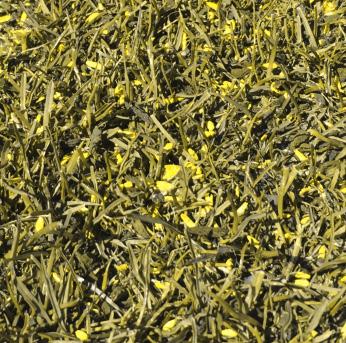
A recognized leader in innovative grass seed coating, Barenbrug’s Yellow Jacket® Enhanced Seed Coating has been providing the professional turfgrass seed industry with quality coated seeds since 2007. Since this time, millions of pounds of Yellow Jacket enhanced seeds have been sold across the United States.
Yellow Jacket Establishment
Increased growth in Yellow Jacket coated seed versus uncoated seed. One study showed an increase of 14% in plant biomass in the first year. Below, the Yellow Jacket coated seed, in pot "ZT-60" clearly outperformed the non-coated seed.

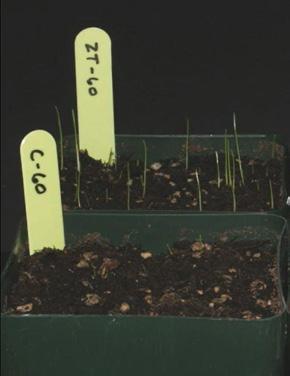
Enhanced Turf Quality
All coated entries exhibited improved turf ratings and disease performance a full year after seeding. After the study, it was clear Yellow Jacket coated seed improves turfgrass quality, density, and disease ratings.
Day 6 Day 8
Yellow Jacket Key Features
• Same rate, same quality
• Extended seeding window
• Better seed survival • Easier visual monitoring
Scan here to learn more about Yellow Jacket

Results You Can See
• Turfgrass seeds vary in size, and depending on the soil type, and many are nearly impossible to see during application. If you’re the 1 in every 12 men or 1 in every 200 women with some form of colorblindness, it might become even more difficult., it might become even more difficult having some form of colorblindness.
• Yellow Jacket maximizes color contrast by making seed more visible to all end users, regardless of seed size. Yes, we see you, creeping bentgrass!
• Something as simple as color can save time and money by preventing “skips” in the seeding process.

19
TF/KBG Mix North
0 1 2 3 4 5 6 8 7
Carolina State University
Kentucky Bluegrass Turf Saver RTF Perennial Ryegrass Creeping Bentgrass coated uncoated
No Color Blindness Simulated Deuteranopia Simulated Protanopia
Products
The products and the support to tackle the toughest opponents on the field.
With over 10,000 golf courses, 22,000 city parks, tens of thousands of sports fields, and countless home lawns it’s no surprise to us to hear how different your needs and experiences are.
Whether you’re managing a remote, 9-hole links course in Iowa, the sole owner of a starting Lawn and Landscape business, or the sports field manager of a premier university, we have the knowledge, research, and breeding to help find a solution to your problem.
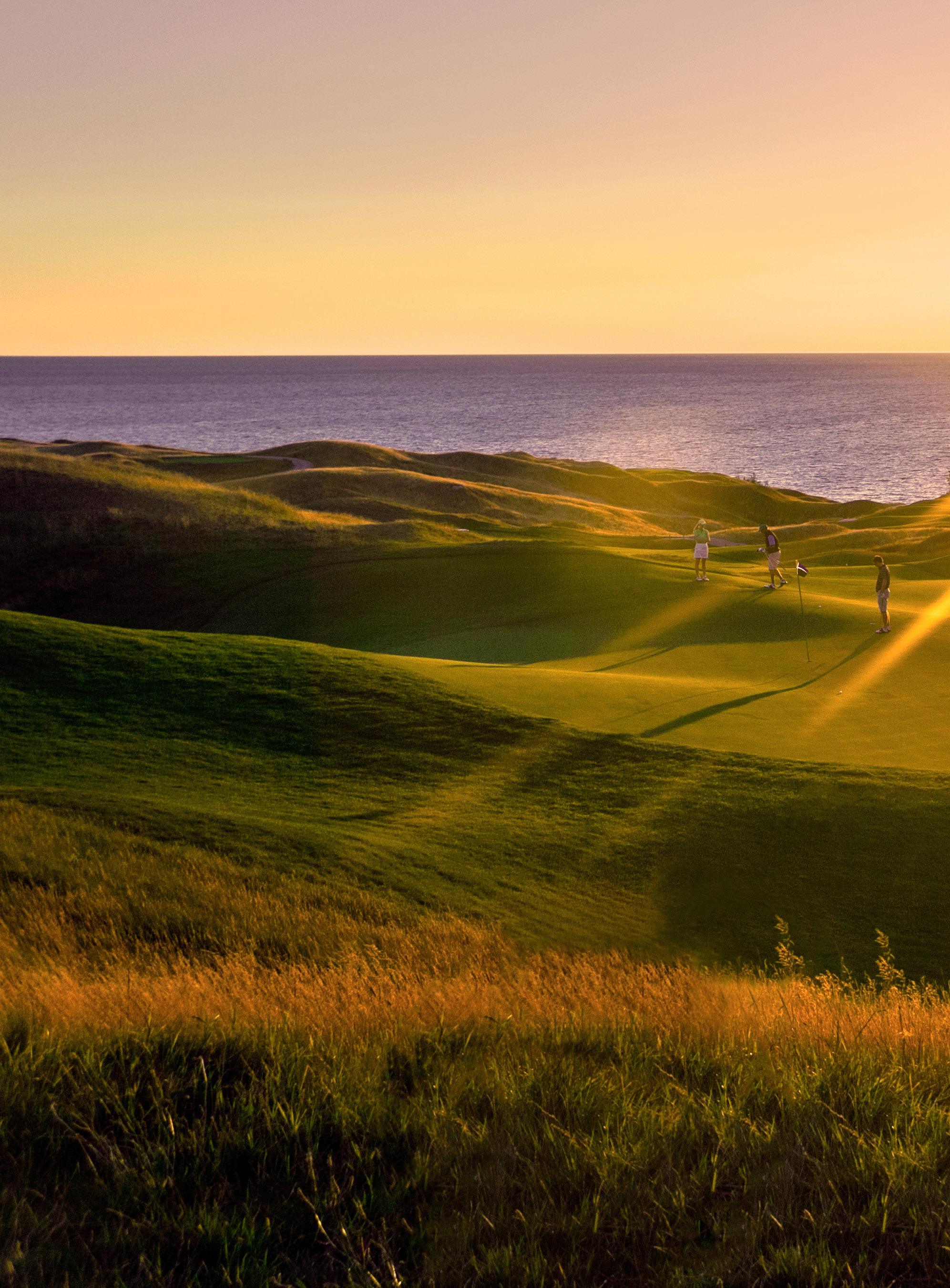
At Barenbrug’s breeding stations, ongoing research, breeding, and trialing for new varieties and blends aim squarely at providing you with the top scoring cultivars to enhance your turf!
We are honored to have our RTF utilized on Omaha Country Club’s course. Read more about how it has provided an innovative solution on page 34.

Kentucky Bluegrass


HGT® features the very best of Barenbrug’s Kentucky bluegrass varieties. Starring Barvette HGT®, the HGT blend has outstanding bluegrass performance in the most difficult of climates, including the Transition Zone and the Northeast. Barvette HGT is quick to germinate and fast to establish meaning HGT will provide year-round performance in the spring and late into the season.
With three consecutive ‘Field of the Year’ awards, HGT has proven to be in a class of its own. To top it off, Barvette HGT®, a component of HGT, has consistently ranked #1 in recent NTEP trials for various traits, so you know, when you plant HGT, you’re planting an award-winning grass.

22
Aggressive Growth Disease Resistant Extremely Traffic Tolerant Key Features
Features
• HGT® with Yellow Jacket ® • HGT® Sod • HGT® with RPR® • HGT® with RPR® with Yellow Jacket ® HGT® is available in each of the following alternative forms: STMA Field of the Year
•
5, high-quality, strong performing bluegrass varieties
Top: HGT Sod, Illinois Above: HGT, Cedar Rapids, IA. @ParkerBechen HGT® Parker Bechen Cedar Rapids, IA “Even with the real feel in the 100’s, the HGT is still money!”
• Unmatched summer patch performance
HGT® bluegrass blends are ideal for Kentucky bluegrass sod production. Vigorous to germinate and establish, HGT quickly forms strong rhizomatous growth with an extensive root system. This growth allows for excellent ‘sod strength,’ reduced field waste, great pallet appearance, and quality ‘big roll’ installations.
HGT Sod is available exclusively through the Turf Producers Association. To learn more visit: www.hgtsod.com




Traffic Tolerance: ‘11 NTEP Final Report
Variety Score
Barvette HGT 6.2 Barserati 5.7 Midnight 5.3 Shamrock 4.9 A06-47 3.4
L.S.D. 0.7
Left: HGT at the OK State NTEP trial taking over plots with its aggressive nature and disease resistance.
Turf Blue® Pro
Drought Tolerant
Disease Resistant
Darker Color
Key Features
• Features 4, high-quality bluegrass varieties including Midnight type
• Powered by the high NTEP ranking Barserati™
Drought Tolerance
Barserati™ drives Turf Blue Pro in performance and has proven its exceptional drought tolerance time and time again. Having been independently tested in New Mexico and Kentucky, Barserati not only possesses drought tolerance, but heat and humidity tolerance as well.
In the NTEP trials, Barserati™ ranked high in turf quality, color, traffic tolerance, and disease resistance. Additionally, having been independently tested in New Mexico and Kentucky, Barserati exhibits exceptional drought tolerance. With early spring green up and strong summer performance, Turf Blue® Pro can be counted on to provide year-round bluegrass quality.
Turf Blue Pro is available in each of the following alternative forms:
• Turf Blue ® Pro with Yellow Jacket ®
• Turf Blue ® Pro with RPR ®
• Turf Blue ® Pro Sod
Above: Turf Blue Pro, Glendale, CO
23
HGT® Sod
Tall Fescue
Turf Saver® RTF® is the most advanced and unique tall fescue mixture available, providing the benefits of rhizomes not found in any other varieties. While other spreading varieties describe “potential” rhizome development or “aggressive tillering,” the deep-rooted and heat-tolerant Turf Saver RTF has been proven to mend damaged turf and maintain both uniformity and density.
RTF® is available for sod production exclusively through the Turf Producers Association: www.rtfsod.com


RTF® Sod provides the fastest route to the RTF experience. From sod harvest to the installation of a mature stand in a matter of hours or days, RTF Sod is formulated with a larger portion of RTF varieties. The deep-rooted and heat-tolerant RTF Sod has been proven to maintain both uniformity and density while repairing itself after damaging events. RTF Sod is grown through a network of sod growers, and has its own association, with research and development ensuring the continual improvement of the product to supply RTF for generations to come. If sod isn’t an option for larger repairs, it is recommended to use Turf Saver RTF to match texture and uniformity in color.

24
water, no problem. RTF Tall Fescue sod with municipal irrigation ban in effect. That’s confidence. No net, no problem.” Self-Repairing Darker Color Drought Tolerant Self-Repairing Darker Color Drought Tolerant Turf Saver® RTF® RTF® Sod
“No
Bill
S. Suffield, CT
• Drought tolerant
• Summer persistent
• Disease resistance



This 3-way turf-type tall fescue blend performs exceptionally in the U.S. Transition Zone and most areas from Colorado to California all while providing an economical option. In deep soils, Water Saver can establish deep roots, providing improved drought tolerance and good summer persistence. Water Saver contains varieties with improved leaf texture and excellent disease resistance.
• Commercial landscape
• Parks & recreation
•
rough,
Drought Destroyer™: Tall Fescue & Kentucky Bluegrass Mixture

Drought Tolerant Retains Color Widely Adapted
Drought Destroyer® is a product designed to withstand even the most excruciating droughts. This mixture contains varieties that have been trialed extensively for drought while retaining appealing turf quality. Drought Destroyer has been tested for drought tolerance across the country for acute and chronic drought conditions at independent research locations as well as universities.
Drought Tolerant
Pollinators Paradise® is a unique, specialized mixture that is safe for the environment and its pollinating creatures. This product will flower beginning in spring through parts of the summer, providing pollinators with a food source. Other environmental benefits will include soil remediation and stabilization. Capturing atmospheric nitrogen and releasing it into the soil and surrounding turfgrass will result in a healthier plant community compared to products without clover.
25
Saver®
Golf club grounds,
and driving range Advantages: Applications: Drought Tolerant Rapid Germination Dark Green Color Economical Solution Water
Benefits Pollinators Nitrogen Fixation
Pollinators Paradise™: Tall Fescue & Turf Clover Mixture
Premium Perennial Ryegrass
A mixture of RPR® varieties and elite Perennial Ryegrass, RPR® is the solution for all golf, sports, and recreational facilities where elite Perennial Ryegrass quality is required. RPR’s extreme wear tolerance and ability to recover thin and damaged turf are unique to the industry. Extremely fast germinating and quick to establish, RPR can also be overseeded into traditional cool-season turf lawns, such as Kentucky Bluegrass, Fine Fescue, and traditional Perennial Ryegrass.
Grey


Leaf Spot Resistance Dark Green Color
Top: Turf Star RPR at Walker Stadium, Portland, OR Far Right: Turf Star RPR, Washington State @TeelowM3

26
John Cogdill City of Boulder Parks and Rec
Germination Insect Tolerance Quick Wear Recovery Deep
RPR®
“These grasses reduce the amount of herbicides and pesticides you use and provide great coverage. With RPR we’ll see emergence in just seven days”
Rapid
Green Color
Traffic
Dense
Turf Star® is a 3-way blend of superior quality Perennial Ryegrasses for virtually all golf, sports turf, and recreational applications in cool to temperate climates. Featuring dark green perennial ryegrass varieties with strong genetics and mechanical purity, Turf Star is a popular choice when high quality is desired. Fast to germinate and quick to establish, Turf Star features strong traffic tolerance and good recovery. Growth
Tolerant
Contiguous
Turf Star®
As a Perennial/Annual mixture, Duo Pro™ can be utilized in cool-season and warm-season areas as an overseed. With fast germination at lower-temperatures, Duo Pro repairs cool-season fields during the worst of growing conditions, when the threat of thinning turf and annual bluegrass invasion is always present. Warmseason areas overseeded with Duo Pro achieve the look of perennial ryegrass with the lower cost of the turf-annual. During transition, this blend will still require chemical removal due to the perennial components.
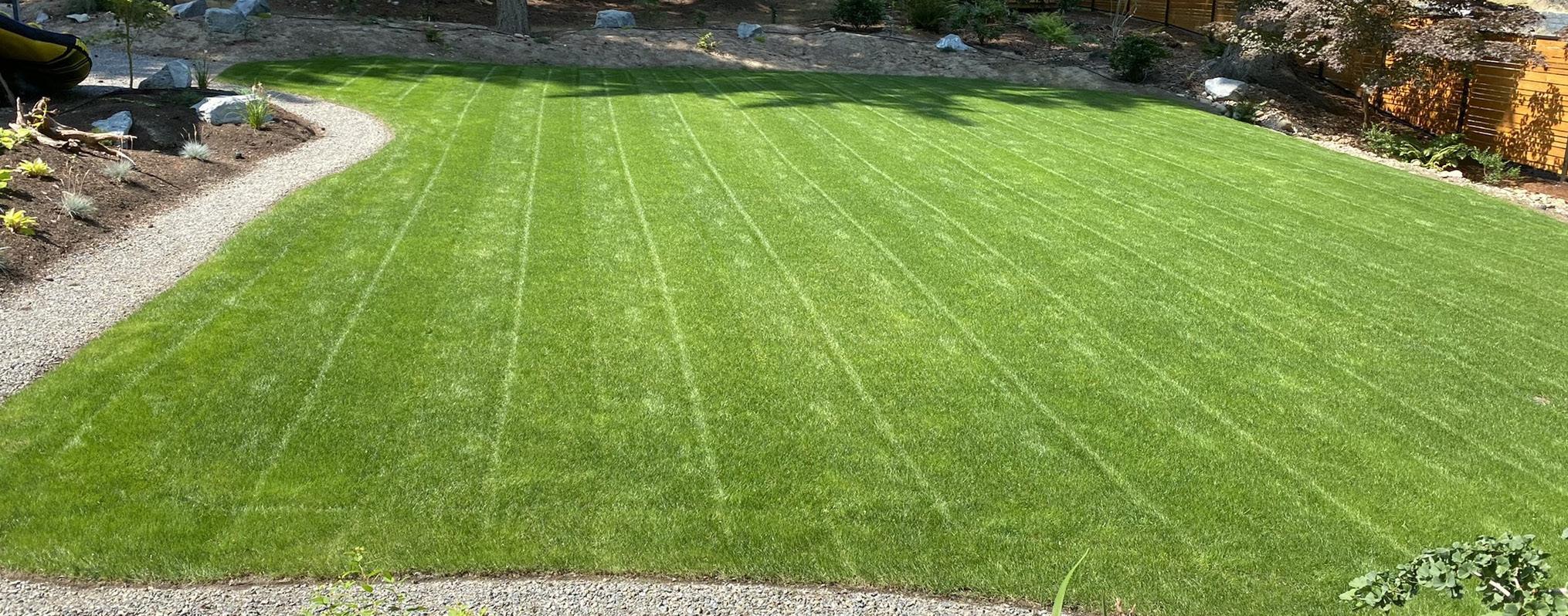

Top Flight™ is a 3-way blend of Perennial Ryegrass varieties designed to be more affordable. With rapid establishment, Top Flight will create lush landscapes for golf courses, parks, sports fields and home lawns. Top Flight germinates fast while quickly establishing a dense turf. When used for warm overseeding, Top Flight is less competitive against Bermudagrass making it easier to remove than elite perennial ryegrasses.
XPC™ is a unique blend of Perennial Ryegrasses designed to not accentuate your Poa annua problem, but help conceal it. Utilizing varieties that have a more natural color, XPC is made up of carefully selected Perennial Ryegrasses that exhibit increased density and tolerance to lower mowing and stress from wear. These characteristics enable the novel XPC blend to better compete with Poa annua and mask its presence.



27
Light Green Color Reduce Appearance of Poa Very Fine Texture XPC™
Competes with Poa annua Mid 40˚ F Germination Fast Establishing Extended Persistence Duo Pro™
Ryegrass
Perennial
Fast Establishment Fine Leaf Texture Economical Solution Top Flight™
Turf-Type Annual Ryegrass
SOS™ can provide enhanced turf-annual quality in warm season overseed applications including golf courses, sports fields, low use areas, and home lawns. End users will enjoy reductions in mowing and required fertility compared to Gulf. For colder winter climates, SOS will also germinate with soil temperatures in the mid-40’s (Fahrenheit), enabling areas to be repaired after heavy play and allowing continued use.

Below: SOS, Santa Clara, CA

28
Chemical-Free Spring Transition Mid 40˚ F Germination Darker Color Improved Turf Quality
SOS™
Bentgrass


29
we
superintendents
You will
varieties.
Fairways Greens Variety Genetic Color Leaf Texture Spring Green-up Dollar Spot Tolerance Thatch Production Most Similar To L-93 XD™ Medium Green Very Fine Good Excellent Mod-high (depends on management) Pure Distinction, Pure Select T-1™ Very Dark Green Moderately Fine Very Good Good Mod-Low Penn A4, Penn A1 (texture) V8™ Medium Moderately Fine Good Excellent Low Penn
Penn A1 (texture) Kingdom™ Very Dark Green Moderately Fine Moderate Moderate Moderate Penn
Penn A1 L-93™ Medium Green Moderate Moderate Good Moderate Penncross, Pennlinks II Bengal™ Medium Light Green Moderately Fine Moderate Good - L-93, Alpha Scan
to
about Bentgrasses
We know that each and every golf course is unique. Because of this, we know each course faces its own set of problems. Offering some of the best bentgrass genetics on the market today,
are proud to carry varieties that help solve many of the challenges
face today.
find the icons below next to certain
Although it does not limit the variety to these uses, they designate where this variety will perform the best on your course. Tees
A4,
A4,
here
learn more
Fine Fescue
With a very fine leaf texture, low growth characteristics, and exceptional density, Fine Fescues are a common component of shade mixtures, erosion control blends, and low-maintenance turf in golf and landscapes. In cooler, temperate climates, established fine fescue lawns can also have good drought tolerance, low fertility requirements, and will tolerate deep shade to full sun. Barenbrug offers various fine fescue species for use in mixes for landscape, golf, erosion control, unmowed naturalized areas, and low maintenance turf areas; each providing unique benefits to maximize turfgrass sustainability.
The Five Species of Turf Fine Fescue

and Their Characteristics
Sub-species Available: • Chewings Fescue • Strong Creeping Red Fescue • Slender Creeping Red Fescue
• Hard Fescue • Sheep Fescue
Limited to cool, moist climates. Useful under adverse fertility, pH
Limited to cool, moist climates. Useful under adverse fertility, pH
Limited to cool, moist climates. Useful under adverse fertility, pH

Drought and heat tolerant. Adapted in transition zone areas.
Drought and heat tolerant. Adapted in transition zone areas.
30
Source: Brede, D. (2000). Turfgrass Maintenance Reduction Handbook: Sports, Lawns, and golf. Ann Arbor Press. Chewings Fescue Strong Creeping Red Slender Creeping Hard Fescue Sheep Fescue Latin Name F. rubra ssp. commutata F. rubra ssp. rubra F. rubra ssp. litoralis F. brevipila F. ovina Spreading Very Little Strong Little Very Little Very Little Height Moderately Low Moderately Tall Medium Low Low Leaf Texture Fine Broad Medium Fine Fine and Wiry Leaf Color Light-Medium Green Medium Green Light-Medium Green Dark Grayish Green Powdery BlueGreen
Usefulness in Low Maintenance
Dunes Mix™
Shade Tolerant Early Spring Green-up
Medium-to-Dark Green Color


Our Dunes Mix™ is a superior quality mixture of our genetically advanced fine fescues of Chewings fescue and slender creeping red fescue. Recently rejuvenated with improved genetics, these two types of fescues come together to create the “dunes” look found on many of the world’s finest golf courses. Dunes Mix provides improved density, a finer texture, and better stress tolerance.

Shade Savant™: Fine Fescue & Perennial Ryegrass Mixture
Drought Tolerant Fast Establishment Fine Leaf Texture
Shade Savant® is a fine textured mixture that provides ornamental value even in areas plagued with shade. This product was initially tested for drought tolerance and was found to be more drought tolerant than any of its individual ingredients, exhibiting additive effects! Shade Savant will adapt to the level of sunlight exposure, whether planted in full sun or deep shade.
Top Left: Dunes Mix, Bandon, OR Above: Barenbrug Fine Fescue, WI
31
Quick to establish and best-suited for full sun locations, Bermudagrass is heat-tolerant and capable of developing a deep, extensive root system. When fully established, bermudagrass requires significantly less water than traditional cool-season species to provide a quality turf surface. Both stoloniferous and rhizomatous, bermudagrass exhibits high density, strong traffic tolerance, and excellent traffic recovery when mowed at 1” or lower.
PanAm provides a high-quality turf suitable for golf fairways, tees, intermediate-roughs, and driving ranges. Also ideal for lawns, green belts, and parks and rec turf situations, PanAm is an economical blend of seeded turf-type bermudagrasses such as Bargusto™, Transcontinental™, and Chilly Verde™. PanAm contains strong genetic diversity and can be applied across various warm-humid regions within the United States.


32
Comparison of Available Bermudagrasses Hybrid Elite Types PanAm Arizona Common Cost $$$$$ $$$ $$ $ Turf Quality High Maintenance 5 4 3 2 Turf Quality Low Maintenance 4 4 3 2 Percent Winterkill 5 5 3 1 Spring Dead Spot 5 5 3 3 Genetic Color 5 4 3 3 Leaf Texture 5 4 3 3
below, Elite Bermudagrasses
are
option for those seeking
Hybrid
quality
cost!
Traffic Tolerant Medium-Dark Color
Shown
like Monaco and Hollywood
a great
a
Bermudagrass-like
without the
Early Spring Green-up
Seeded Bermudagrass PanAm® Blend
Monaco is a highly ranked variety tested in the 2013 NTEP trials and possesses a rare combination of traits in exceptional wear tolerance, high winter hardiness, and early spring green-up. Monaco is excellent for use on golf courses, sports turf, and higher- quality lawns, producing a quality grass surface that appears early, withstands a multitude of stresses, and stays late into the year.


33
Drought Tolerant Early Green-Up Dark Green Color Elite Seeded Bermudagrass Monaco® Elite Bermudagrass
Barenbrug & Omaha CC
Eric McPherson and his team at Omaha CC have hosted two U.S. Senior Opens and taken daily conditioning to new heights in his decade-long tenure.
 By Pat Jones
By Pat Jones
“When I got here in 2011, the rough was not consistent. We talked to the members and asked fundamentally, what do you want roughs to be? The membership wanted rough that was consistent day-to-day and throughout the year. And they said if I’m in the rough on #2, I think it should be similar to the rough on #12. So, consistency is what we set out to accomplish.
We used a Tenacity program to remove weeds and weedy type turfs like weaker blues and ryes. All the bentgrass and poa annua got smoked too. It’s an intense process and it turns weeds white. As much as we told members it was going to be a shock, it was still a shock. The next step was to immediately introduce RTF turftype tall fescue into all the roughs. We aerated and interseeded in all the thin areas. By mid-April we had rough that was 70-80% tall fescue. It looks phenomenal and plays great. This turf doesn’t stress that much during summer, it takes the traffic extremely well and it doesn’t desiccate much during our winters. We were able to eliminate some big problems by introducing RTF.”
But you kept finding ways to use it, particularly in sod, correct?
“As we completed more projects – green surrounds, bunker surrounds, etc. – we kept using RTF sod. We noticed that when we go through a drought in summer, it doesn’t lose its color and it stands up to traffic so well.”
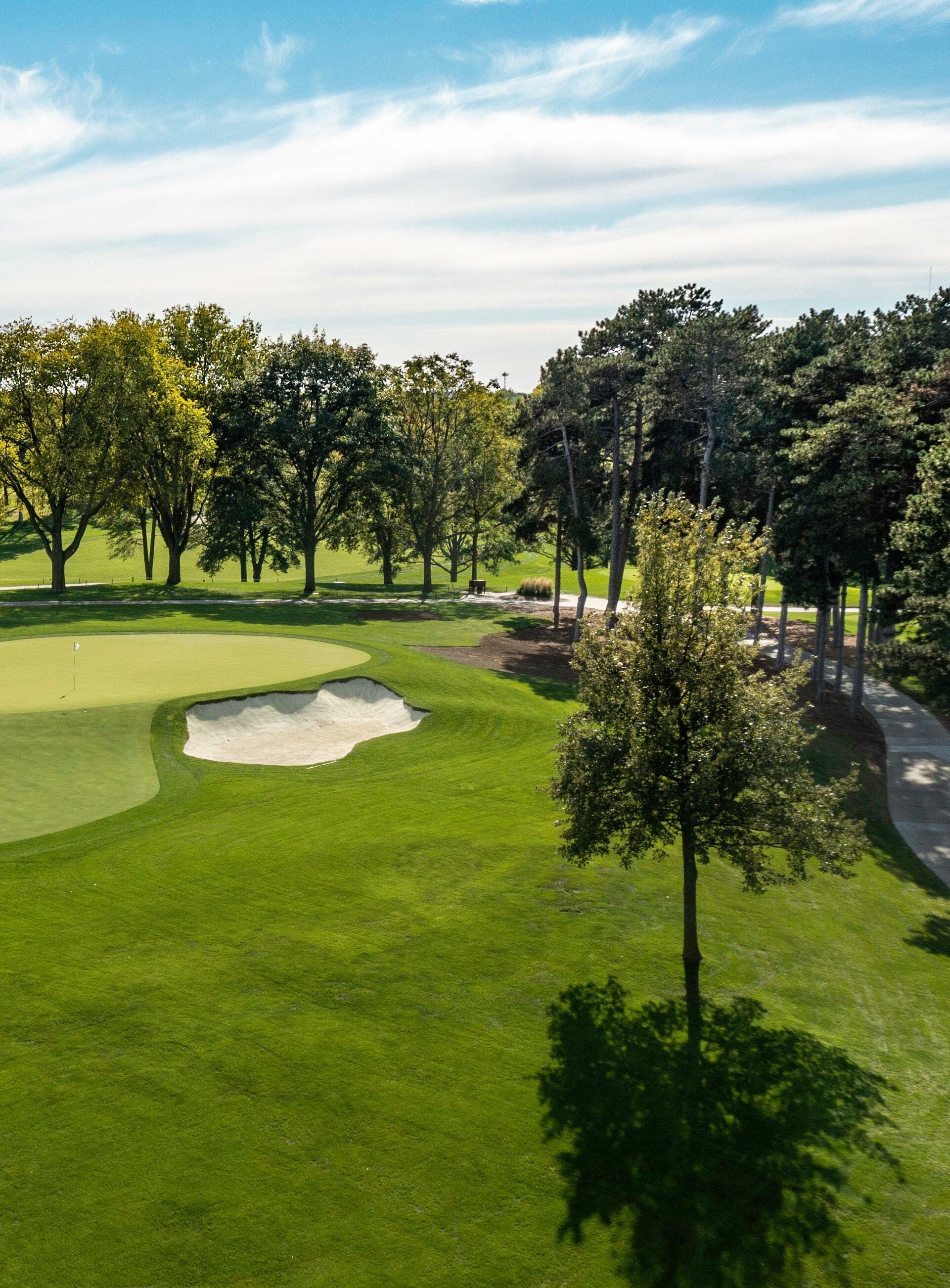
You joined the “no collars club a while back. Tell us how that’s going?
That is part of our return to timeless golf design. Collars weren’t really a thing in golf until the ‘50s. And they really can be a problem. They get beat up and can get overregulated. I didn’t know what to think about it when we made the switch but, today, I wouldn’t do it any other way. Instead of a collar we have intermediate RTF rough mowed at about an inch. It is a fantastic turf. It takes all the wear, it never goes off color and handles all the stresses. It reminds me of a thick pair of wool socks that just never wear out. The great thing is members can chip, putt, pitch off of it… they have tons of options to play. One other thing that’s unique about having RTF right next to your bentgrass greens is you can put all the wear you want to put on it and it’s no problem. We use turning boards less often. Also, RTF just eats growth regulators. There’s no effect on density or discoloration or shortening of the plant. RTF is practically unimpacted by PGRs, which is key.”
How about taking care of it?
We don’t have to worry about disease and we no longer have billbug issues. It needs to be fed at that intermediate height. You need to feed it throughout the season in ways that do not encourage a lot of growth. In short, not a ton of nitrogen is needed.
Why has RTF been important to your program?
How does it recover from damage?
“Divots heal quickly. It’s self-repairing. There’s no divot filling necessary. As an intermediate rough where there are a lot of shots played along the fairways, I think it’s great because it fills in nicely.”
“Overall, RTF handles wear, disease, insects and stress flawlessly and has fantastic color all season long. It makes our life easier especially in this climate. It really performs well…the way we need it to perform at Omaha CC.”
“As we completed more projects – green surrounds, bunker surrounds, etc. – we kept using RTF sod. We noticed that when we go through a drought in summer, it doesn’t lose its color and it stands up to traffic so well.”
Additional Products
Rapid Establishment


Low Inputs
Barenbrug’s Contractor’s Mix provides quick cover when needed, at any time of the year, at an affordable price. This turfgrass mixture will germinate quickly to prevent soil degradation and provide erosion control in all conditions. This mixture will rapidly anchor into the soil substrate, later transitioning to a permanent crop and decreasing the likelihood of weed encroachment.
Green Color
Leaf Texture
Havana is an improved Poa trivialis developed for fall and winter overseeding of warm-season grasses in the desert southwest, south, and southeast regions. Havana exhibits a quick, smooth spring transition allowing the rapid recovery of bermudagrass. It will not persist into the next overseeding year. With approximately 2.3 million seeds per pound, it can be used at low seeding rates as a monostand or blended with other Poa trivialis varieties. With rapid germination and fast establishment, Havana also performs well in overseeding mixtures with perennial ryegrass, fine fescue, and creeping bentgrass.
Turf Clover™ (Trifolium repens) is a perennial white clover growing to approximately 4 - 6 inches tall, making it ideal for a lawn alternative or as an addition to an existing lawn. It is a finer leaved white clover, primarily spreading by stolons that travel outwards on the soil surface which root as they come into contact with the soil surface. Adding just 2 - 5% of Turf Clover to a grass seed mixture will result in enough seeds to fill a lawn. These seeds are packaged pre-inoculated with Rhizobia that are required to trigger processes that enable the plant to “fix nitrogen.” This is a unique ability to clover, which is pulling nitrogen from the air and fixing or converting it to a plant-usable form. This makes Turf Clover a great companion for cool-season turfgrass species.
36
Contractor’s Mix
Barbian™: Turf Clover™
Medium
Dark
Fine
Excellent
Drought
Miniature
Nitrogen
Havana: Poa trivialis Additional Products
Texture
Spring Transition
Tolerant
Size
Fixing
Turf Grass Identification



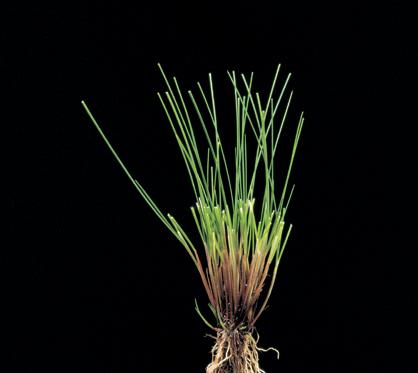
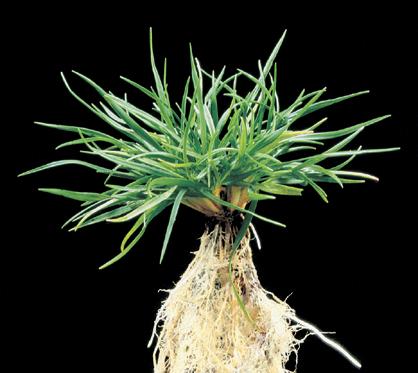
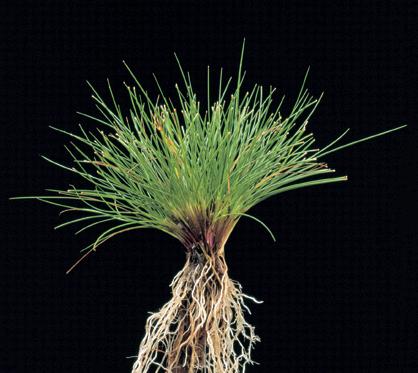

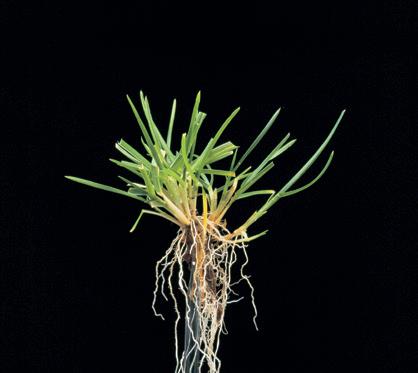

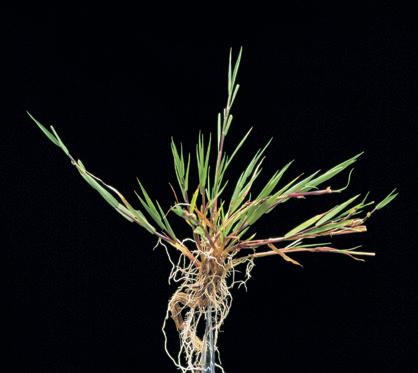
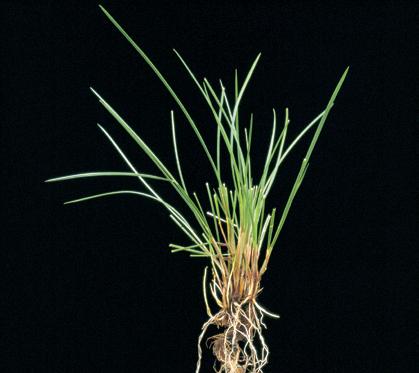

37
Perennial Ryegrass Lolium perenne L.
Strong Creeping Red Fescue Festuca rubra L. ssp. rubra
Creeping Bentgrass Agrostis stolonifera L.
Tufted Hairgrass Deschampsia caespitosa L. P. Beauv.
Kentucky Bluegrass Poa pratensis L.
Chewings Fescue Festuca rubra ssp. communtata
Hard Fescue Festuca trachyphylla
Crested Hairgrass Koeleria macrantha (Ledeb.) Schult.
Slender Creeping Red Fescue Festuca rubra ssp. litoralis
Colonial Bentgrass Agrostis capillaris L.
Tall Fescue Schedonorus arundinaceus Schreb.
Annual Bluegrass Poa annua L. Turf Grass Identification
Source: Beard, J. B. (2013). Origins of North American Turfgrasses. ASA-CSSA-SSSA Turfgrass Monograph, P. 1-35.
Species & Characteristics
Perennial Ryegrass Perennial Ryegrass(RPR) Tall Fescue Kentucky Bluegrass Seeded Bermudagrass Annual Ryegrass
Genus Lolium Lolium Festuca Poa Cynodon Lolium
Specific Epithet perenne perenne arundinacea pratensis dactylon multiflorum Subspecies - soloniferum - - - -
C-Fixation Type C3 C3 C3 C3 C4 C3
Growth Habit Bunch Determinate Stolons Bunch/ Rhizomes Rhizomes Stolons/ Rhizomes Bunch
Establishment Fast Fast Moderate/ Good Slow/ Moderate Slow/Moderate Fast
Wear Tolerance Good/Very Good Good/Very Good Moderate/ Good Good Very Good Poor/ Moderate
Recovery Slow Moderate Slow/ Moderate Moderate/ Fast Fast Slow Thatch Production Little Some Little Some Excessive Little
Heat Tolerance Moderate/ Good Moderate/Good Very Good Good The Best Very Poor
Salt Tolerance Poor Poor Good Moderate Very Good Poor/ Moderate Fertility Requirement Moderate/ High Moderate/High Low/ Moderate Moderate Moderate Moderate/ High
Mowing Recommendation 0.5”-3” 0.5”-2.5” 1”-3.5” 0.5”-3” 0.5”-1” 0.5”-3”
Drought Tolerance Poor/Good Moderate Very Good Good Very Good Poor Leaf Texture Fine Fine Moderate/ Coarse Fine/ Moderate Fine/Moderate Fine/ Moderate
38 Species and
Characteristics
Seeding Rates Seeds/Pound lbs/1000ft2 lbs/acre kg/ha g/m2 Creeping Bentgrass 7,000,000 0.75-1.25 35-55 37-61 4-6 Colonial Bentgrass 5,000,000 1-2 45-90 49-98 5-10
450,000 4-6
20-30
Red Fescue
4-6
sizes among bluegrass varieties differ greatly. This represents an average
Chewings Fescue
175-260 195-295
Creeping
450,000
175-260 195-295 20-30 Hard Fescue 500,000 4-6 175-260 195-295 20-30 Tall Fescue 250,000 8-10 350-435 390-490 40-50 Kentucky Bluegrass 1,300,000 2-3 65-110 75-120 10-15 Perennial Ryegrass/RPR 250,000 8-10 350-435 390-490 40-50 Annual Ryegrass 200,000 10-15 435-650 490-730 50-75 Common Bermudagrass 1,400,000 2-3 45-130 100-145 10-15 *Seed
39 Species & Characteristics Creeping Bentgrass Colonial Bentgrass Chewings Fescue Creeping Red Fescue Hard Fescue Genus Agrostis Agrostis Festuca Festuca Festuca Specific Epithet stolonifera capillaris rubra rubra brevipila Subspecies - - fallax litoralis/rubraC-Fixation Type C3 C3 C3 C3 C3 Growth Habit Stolons Bunch Bunch Rhizomes Bunch Establishment Moderate Moderate Moderate Moderate Poor Wear Tolerance Poor/Moderate Poor Poor Poor Poor Recovery Fast Slow Slow Moderate Slow Thatch Production Excessive Moderate Moderate Excessive Moderate Heat Tolerance Very Good Poor Poor/Moderate Poor/Moderate Poor/Moderate Salt Tolerance Good Moderate Poor/Moderate Poor/Good Good Fertility Requirement Moderate Low Low/Moderate Low/Moderate Very Low Mowing Recommendation 0.125”-1” 0.200”-1” 2”-3.5” Or No-Mow 2”-3.5” Or No-Mow 2.5”-3.5” Or Now Mow Drought Tolerance Moderate Moderate/Good Good Good Very Good Leaf Texture Very Fine/ Moderate Fine Very Fine Very Fine Very Fine

Contact Us Barenbrug USA 33477 HWY 99E PO Box 239 Tangent, OR 97389 P: (541) 926-5801 P: (800) 547-4101 F: (541) 926-9435 E: info@barusa.com W: www.barusa.com ® Make Life Beautiful B120123






















































































 By Pat Jones
By Pat Jones




















